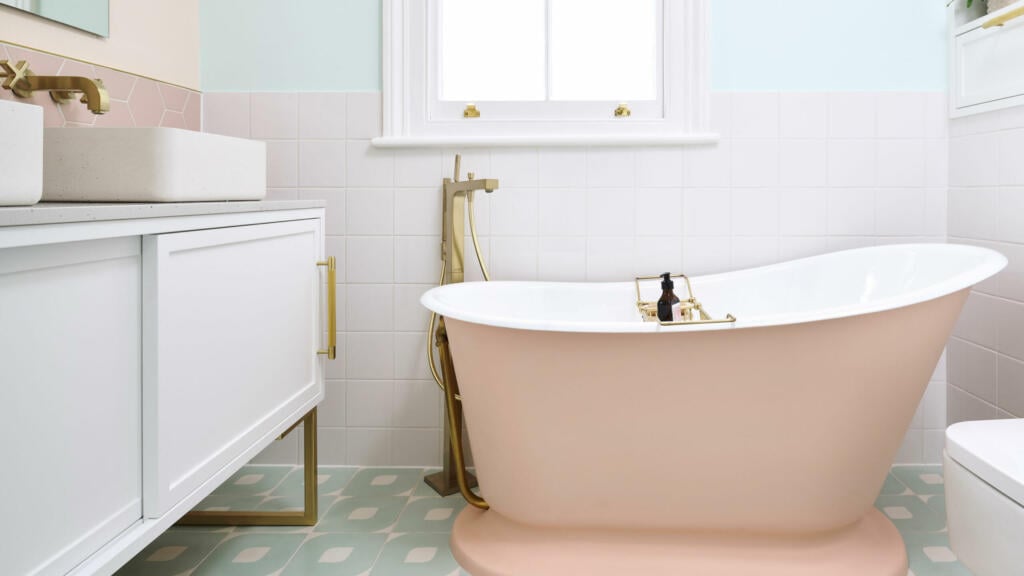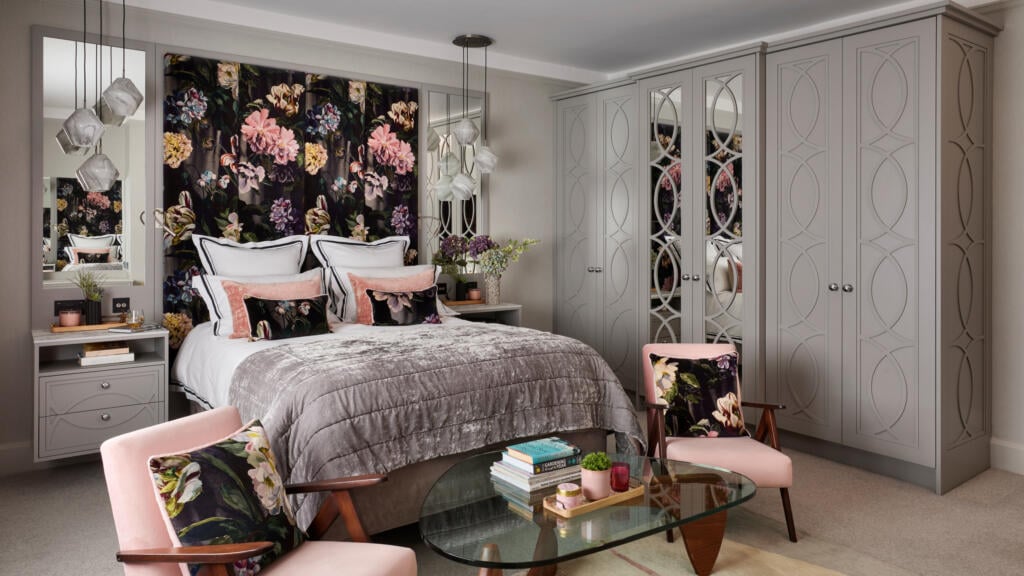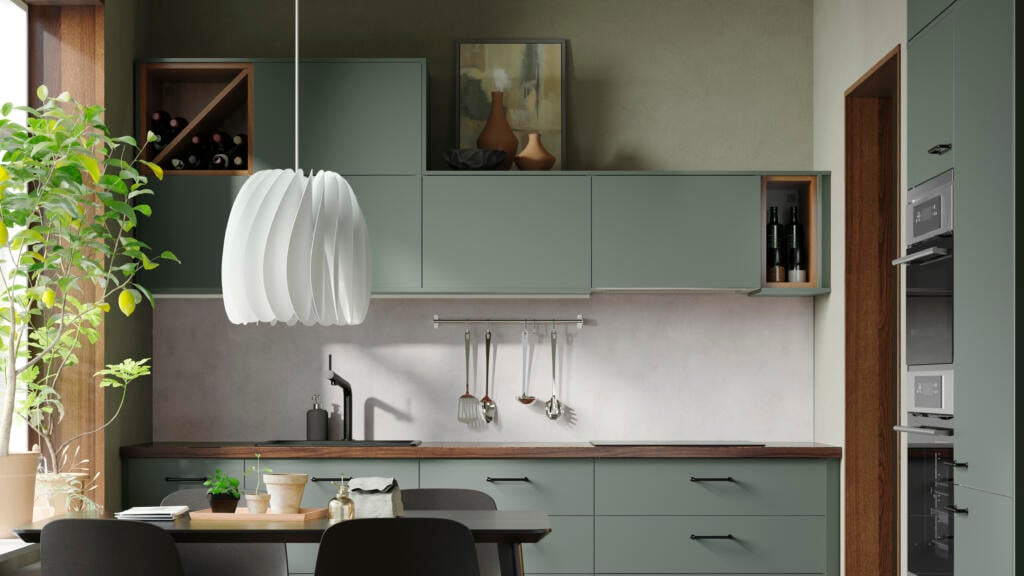
15 bedroom layout ideas that make the most of your space
Joy Archer
A small bathroom is one you can still be proud of.
Beauty is in the eye of the beholder and yes, even small bathrooms can deliver a coveted, lofty aesthetic. Getting ready for the day ahead in a space that feels as claustrophobic as the cupboard under the stairs is not the inspiring start that anyone needs.
As James Greenwood, of Graham & Brown, says: “Creating a sense of space especially in smaller rooms such as bathrooms can often be daunting.”
So to help make this less of an overwhelming task, we spoke with experts in the interiors world who kindly shared their secrets to making a small bathroom look bigger. Mirrors, light colours, and small versions of everything are just the start, with many encouraging us to embrace the unexpected for surprisingly spacious results that delight and uplift the senses.
It seems that there is more to it than simply painting your walls white after all…
Beauty is in the eye of the beholder and yes, even small bathrooms can deliver a coveted, lofty aesthetic. Getting ready for the day ahead in a space that feels as claustrophobic as the cupboard under the stairs is not the inspiring start that anyone needs.
As James Greenwood, of Graham & Brown, says: “Creating a sense of space especially in smaller rooms such as bathrooms can often be daunting.”
So to help make this less of an overwhelming task, we spoke with experts in the interiors world who kindly shared their secrets to making a small bathroom look bigger. Mirrors, light colours, and small versions of everything are just the start, with many encouraging us to embrace the unexpected for surprisingly spacious results that delight and uplift the senses.
It seems that there is more to it than simply painting your walls white after all…
 Credit: Stephen Fletcher Architects/James Fox Davis
Credit: Stephen Fletcher Architects/James Fox DavisContrary to what you may think, while choosing a boxed-in bath may save a few inches literally, visually the impact will be detrimental and it could actually make your small bathroom feel even more starved of space.
A little like when choosing a bed for a tiny bedroom, go as big as you can to enhance the overall feel of the space, as we can see in this bathroom by Stephen Fletcher Architects.
Emma Joyce, brand manager at House of Rohl, tells us: “When designing a compact bathroom, most opt for a boxed-in bath to try and maximise the space. In reality, the result can feel claustrophobic and the room may feel like it’s dominated by a bath.
“A freestanding bath is an intelligent design solution, as it can open up the floor and wall space, creating an illusion of light and airiness.”
 Credit: Ripples
Credit: RipplesThis sweet and succinct, pastel-toned bathroom space, as created by Ripples London senior designer Jo Sangster for interiors blogger Geraldine Tan, owes its uplifting and open feel to the clever use of colour, and considered design features.
Painting the miniature slipper top bath (never out of the question even in a small space) in the same hue as the hexagonal wall tiles brings cohesion, whilst subtly lifting the white elements centerstage for a bright and spacious appearance.
The bathroom also features a brushed brass crosshead basin mixer, wall-hung radiator, and wall-hung rimless WC, the latter two of which are ideal for mini bathrooms, as we will expand on later.
 Credit: Bert and May
Credit: Bert and MayIt’s not surprising that colour and material finishes are important in small space design. “Consider using lightly coloured, reflective tiles to help bounce light around the room,” says Sangster.
Reflective surfaces will always work in favour of a compact space, as they help add dimension to almost any room. Tiling is the perfect place to start in a small bathroom; we love the sophisticated and polished look of the Pearl Pale Glazed Square tile.
Lee Thornley, of Bert and May, shares with us: “The reflective quality of glazed tiles will help a small space feel bigger, as the surface reflects more light around the room.”

 Credit: Ripples
Credit: RipplesMuch like a reflective tile will do, mirrors bounce light around marvellously and serve multiple purposes in a small bathroom space.
As you can see in this Miami-inspired cloakroom created by Ripples Harpenden, the dynamic shape of the mirror to the left of the basin is unexpected and draws the eye around the room.
 Credit: Ripples
Credit: Ripples“Mirrors are incredibly good at brightening up a room by reflecting light,” adds Joyce, who recommends being as bold as to choose a fully mirrored feature wall.
“Purchasing a custom-cut mirror sheet so a whole wall can become a mirrored surface is a smart option,” she adds.
Even if you are keeping a classic mirror placement, consider going bigger.
 Credit: Farrow and Ball
Credit: Farrow and BallAnother design trick when working with a small bathroom space is to choose the right shade of pink.
Patrick O’Donnell, of Farrow and Ball, tells us: “Softer pinks, those without too much blue through them, can be very flattering – ideal for a small bathroom adding warmth without overpowering the space. Think Pink Ground or Setting Plaster in Modern Emulsion for a delicate atmosphere.”
Consider painting all five walls and keeping wall tiles in the same tones to bring the space together furthermore.
 Credit: Farrow and Ball
Credit: Farrow and BallA dark colour in a confined space feels like a no-no, when actually it can be a fruitful move in a small and, dare we say, poky bathroom space.
“While a dark bathroom may feel an overwhelming choice for some, it can be an ideal option for a small or poorly lit room, working with the limitations rather than fighting them,” says O’Donnell.
“Look to the blackest of greens, Studio Green, to go with aged-brass fittings, or to the moodiest of greys such as Plummett, for more urban sensibility..
“If committing to fully dark walls feels a step too far, then use a rich, warmer tone such as Brinjal, or apply as accents on elements like claw-foot baths, vanity units, or tongue and groove details,” he adds.
Whether you go all out, or add darker accents, the results can be much greater than you might expect.
 Credit: GROHE
Credit: GROHEMost of our experts are advocates for keeping things off the ground, and wall-hung toilets and vanities seem to be particularly favourable options for enhancing the flow of a small space. From the toilet to the shower handle, nodding to modernity with concealed fixtures and smooth edges will effortlessly streamline your surroundings.
“To enhance the sense of spaciousness in your bathroom, consider opting for wall-hung fixtures and fittings,” says Ibironke Ugbaja, from Grohe UK. “This design approach effectively creates the illusion of a larger, more open area, yielding a sleek and streamlined aesthetic.”
Ugbaja further notes: “Toilets can be wall-hung with concealed flush frame systems and basins are available in half pedestal and wall-hung options too.”
 Credit: GROHE
Credit: GROHEFluid shapes instantly complement more detailed features and textures, as we can see with the terrazzo wall and fluted shower screen above.
And let’s not forget about taps.
“Wall-mounted taps not only add a touch of elegance but also contribute to the perception of space by leaving the basin surface uncluttered while expanding the area visually,” explains Ugbaja.
 Credit: Ripples
Credit: RipplesThe walk-in shower is just the start of this compact bathroom space that came with a couple of challenging sloped ceilings, just for good measure. Ripples Bournemouth designer Andrea Dall’Orto did a swell job of creating an elegant and lofty-feeling space that is still practical in every way.
The combination of three tile formats works really well in this space, to add dimension and interest. Plus, the wood-effect porcelain floor tiles and white shower tiles enhance the wall of hexagonal tiles.
 Credit: Ripples
Credit: Ripples“In a smaller room I like to avoid more than three different tiles (floor, main wall, feature wall),” recommends Sangster. “This stands even if it is the same tile, for example a marble. In this case I would have a main large format, perhaps a hexagonal floor and then a brick tile feature. All the same tile but different formats.
“If using a brick tile I am a fan of a vertical stack layout. If using herringbone I use this either more sparingly or with a much more pared back wall tile,” shares Sangster, who notes that offsetting a light coloured tile against wood tones can help bring softness to a space too.
 Credit: Daniela Exley Photography/James Fox Davis
Credit: Daniela Exley Photography/James Fox DavisA walk-in shower or wet room might seem out of the question when space is at a premium. But actually it can deliver when it comes to making the most of a small bathroom design. The freestanding bath fits neatly into this compact loft bathroom space that is visually expanded by the continuous pattern of tile.
“There’s more choice now than ever before – not just in terms of sanitary items but decorative finishes too,” notes Joyce.
“Compact freestanding bathtubs, rainfall showers and step-free shower enclosures all create a sense of luxury. Increasingly, homeowners are looking to design their compact bathrooms into wet rooms, which makes the most of every inch. Incorporate clever storage – it’s difficult to achieve a designer look if there are lotions and potions strewn around.”
 Credit: Zoe Brewer/James Fox Davis
Credit: Zoe Brewer/James Fox DavisAlthough natural lighting is on the side of this bathroom, that’s not to say that the floor spots don’t enhance the space, as much as they put the gorgeous Barcelona bath in the limelight.
Sangster notes: “Lighting is key in small rooms, especially where there’s a lack of natural light. Try combining ceiling lights with indirect lighting in recesses and at floor level to make the room feel as bright as possible.”
Be experimental with how you use lighting and look for opportunities beyond the ceiling.
Taking a pared-back approach is Jeevan Seth’s advice. The CEO of JTP says: “Keep the design simple and minimalist and opt for sleek, streamlined fixtures. Keep the countertop and other surfaces clear.”
If you’re not sure where to start, ticking off reflective surfaces like mirrors and glazed tiles is a good jump off point that will almost certainly deliver.
“Mirrors are also a great way of creating the illusion of a larger space,” shares Seth. They add depth and make a small space feel bigger than it actually is by bouncing light around the room.
As we’ve seen, the power of three tile formats can make for brilliant results, as can a continuous flow of the same tile design from inside the shower, out.
“Tiling the shower floor to match the rest of the floor gives one continuous pattern and creates the illusion of more space,” shares Sangster. “Walk-in showers are a great option for smaller bathrooms because they give the feeling of spaciousness, which is harder to achieve with a full enclosure.”
Creating a sense of space, especially in smaller rooms such as bathrooms, can often be daunting.
Naturally, different designers take different approaches to adding colour and pattern in small bathrooms.
Greenwood recommends colour drenching with paint to blur the boundaries of a room: “Taking lighter, warming colours such as Viridis from your skirting all the way onto the ceiling softens the room’s angular edges and doesn’t draw your eyes to certain focal points.”
 Credit: Graham and Brown
Credit: Graham and BrownAnd while tiles are usually the first port of call for pattern, wallpapering is a novel way of shaking up your space. “For interior decorators that want to add some pattern onto the walls, think about using smaller scale patterns such as Stitch Craze Calm.”
Even your window coverings, should you choose to include them, might be able to enhance room in your bathroom. Shutters can make a sleek addition to spaces that want more privacy and room to breathe.
“Shutters are a fabulous way to make a small bathroom look bigger,” says Sally Denyer, digital marketing manager of Shutterly Fabulous.
“Unlike curtains, shutters look minimalist and sleek and take up less space. You can also create a contrast by mixing neutral shutters with bolder colours across accents like towels, accessories and even feature walls.”
Combining textures and colours is a fine way to create a more open-seeming bathroom space. Think about where you can enhance and add interest. It’s all about finding their point in common and balancing looks you love, as Sangster shares: “If clients want a lighter, brighter space, I like to use a variety of tile textures and sizes (a lot of the time the same family of tiles, just different formats).
“I love using greens in bathrooms, as this gives a lovely, warm, neutral feel and can be offset against lighter tones. I love movement within tiles, so the space is not too flat and clinical-looking.”
Put design interest and function at the forefront of your small bathroom design choices and you’ll be able to achieve unexpected, spacious results – without knocking down any walls or moving house altogether.

Written by Camille Dubuis-Welch she/her
Published: Updated:
Camille is a freelance writer based in north London with her cat and two friends. Cam has been in love with everything interior design and garden-related since before she can remember and is the former deputy editor of realhomes.com, where she got to collaborate with some very inspiring DIYers and focus on small-space improvements.

Joy Archer

Camilla Sharman

Sarah Harley

Rachel Ogden